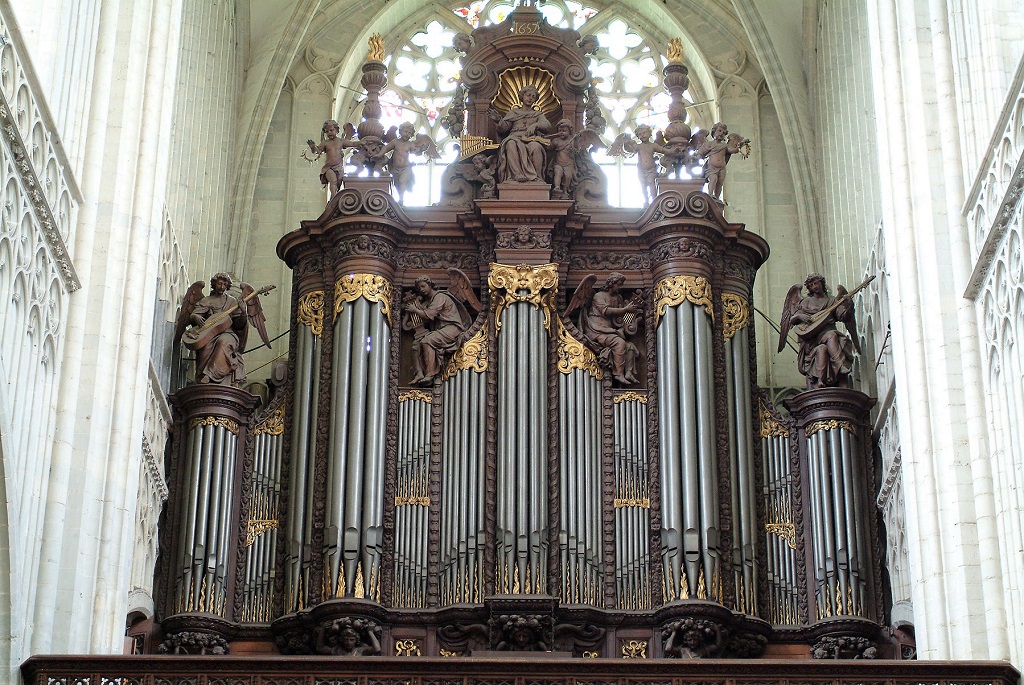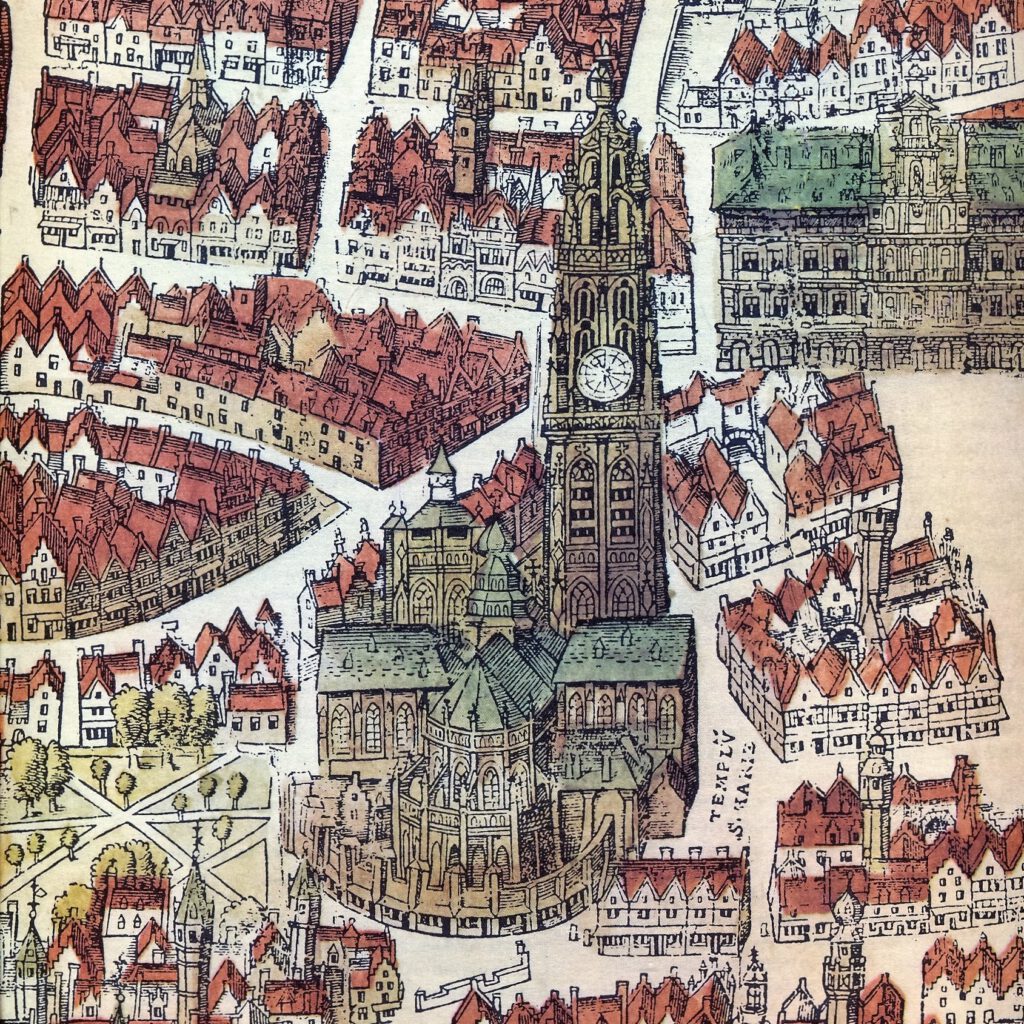The Our Lady’s Cathedral of Antwerp, a revelation.
Pull out all stops: the organs
Until the French Reign there used to be three organs that were positioned on rood lofts of specific spaces: one in Our Lady’s chapel
A small church that is not a parish church. It may be part of a larger entity such as a hospital, school, or an alms-house, or it may stand alone.
An enclosed part of a church with its own altar.
, one in the Venerable chapel and a positive organ on the choirIn a church with a cruciform floor plan, the part of the church that lies on the side of the nave opposite to the transept. The main altar is in the choir. screen to accompany the canons in the choir. Besides there was also the ‘large organ’ in the southern transeptThe transept forms, as it were, the crossbeam of the cruciform floor plan. The transept consists of two semi transepts, each of which protrudes from the nave on the left and right. above the entrance to the ambulatoryProcessional way around the chancel, to which choir chapels and radiating chapels, if any, give way.. After his first instrument had been completely destroyed by the Iconoclast Fury, Gillis Brebos soon constructed a new instrument (1568), with which he acquired international fame. During the ‘purification’ by the Calvinist church councilA large meeting of ecclesiastical office holders, mainly bishops, presided by the pope, to make decisions concerning faith, church customs, etc. A council is usually named after the place where it was held. Examples: the Council of Trent [1645-1653] and the Second Vatican Council [1962-1965], which is also the last council for the time being. in 1581 this organ was wisely preserved, to their own benefit. In 1597, during the Catholic restoration campaign, Servaes van den Broeck manufactured a new statue of Our Lady for the crowning of the Renaissance organ-case. He added a playful element to it: Little Jesus’s right arm could move mechanically, so that when a particular stop was pulled out, He could make a blessing gesture. This must certainly have surprised many a child (and grown-up). The organist who was engaged by the chapterAll the canons attached to a cathedral or other important church, which is then called a collegiate church. In religious orders, this is also the meeting of the religious, in a chapter house, with participants having ‘a voice in the chapter’. and the church board, was usually also engaged by the two devotional chapels, in other words: the same hands played each of the four organs in this church. Some famous organ players were successively Raymundus Waelrant from 1585 and John Bull from 1615. This former organist at the court of Queen Elizabeth of England was an organ virtuoso of international importance, with an innovative style of playing the keyboard. His successor, Hendrik Liberti van Groeningen, was connected to this church first as a chorister and from 1628 as an organist for over forty years. His being well-known outside the world of music is to be credited to his portrait by Antony van Dyck. He also gave advice about the extension of the large organ and the construction of the Baroque organ case in 1657, with sculptures by Peter I Verbrugghen after a design by Erasmus II Quellinus. Although it was sold during the French Reign, this organ remained in the church and was moved to a new rood loft against the western wall of the central naveThe space between the two central series of pillars of the nave. in 1805. In 1889 Pierre Schijven started the construction of a romantic instrument with four manuals with 56 keys each, a pedal board with 30 keys, and 90 stops. The volume of the bellows was adapted so as to contain 13,800 litres. Most of the 5,777 speaking organ pipes – also the tallest ones of about 30 ft – were hidden behind the old Baroque organ front, to which some elements such as the two towers had already been added. This masterpiece of 19th century organ construction is also the largest historic organ in Belgium. It is most suitable for symphonic music composed after ca. 1840. Consequently, in 1891 the honour of playing it in was given to Alphonse Mailly and Charles-Marie Widor, the French composer of organ symphonies.
On top, right above the date ‘1657’, there is an angel with a laurel wreath and a straight trumpet. In the niche is SaintThis is a title that the Church bestows on a deceased person who has lived a particularly righteous and faithful life. In the Roman Catholic and Orthodox Church, saints may be venerated (not worshipped). Several saints are also martyrs. Cecilia, patron of church music. While she is following the score on her lap with her finger, she is keeping time with her right hand. Left of her there is a small portative organ, on her right an angel is playing a triangle with tiny rings. On top of both protruding bundles of pipes there are two angels with gilded laurel wreaths. On the level below four large angels are sitting, with from left to right a guitar, two five string lyres and an archlute. Below the pipes there are trophies with musical instruments: strings, wind section and percussion. From left to right: [1] violin, tenor recorder, Baroque guitar, triangle with (five) rings; [2] harp or lyra da braccio (with bow), cornetto, pommer (a kind of shawm), two recorders; [3] jingle drum (tambourine with jingles), lute, bagpipe, pommer; [4] flutes in one bundle, drum, cornetto (curved zink), wooden transverse flute, and a panpipe.
In the southern transept on the spot where there used to be the large organ a new organ was installed in 1993 by the Swiss company Metzler. ‘Why a second organ?’ many people wonder. It deals with two disadvantages of the Schijven organ: it is closer to the liturgical event and is suited for old, especially Baroque music. This classical instrument has three manuals of 54 keys each, 1 pedal board with 30 keys, 45 stops and 3,322 speaking organ pipes.
It is only when listening to majestic organ sounds that the cathedralThe main church of a diocese, where the bishop’s seat is. really comes alive, during services, during the organ concerts, or at official occasions such as the Te Deum: You God, we praise. You, Lord, we glorify. Since 1963 the musical society Antwerpse Kathedraalconcerten vzw (AKC – Antwerp Cathedral Concerts) has been active, which yearly organises an international organ cycle in Summer, and since 1993 also a series of concerts at noon.
From an age-old tradition the choir singers have been adding lustre to the services in the church on Sundays and days of feast. The earliest indication of organized singers dates back to 1362. As usual, as at court, there were some eight choristers. The cantors, among whom famous ones such as Johannes Ockeghem and Jacob Obrecht in the 15th century, Gerardus van Turnhout and Severin Cornet in the 16th century, gained the Antwerp church choir a high status in the world of those days. From the 17th century it became a usage to bring in instrumentalists at the choral singing, which in the century to come developed into a complete orchestra, with famous kapellmeisters such as Joseph Hector Fiocco and the eccentric Willem de Fesch. In the 19th century solemn services were always graced by a large choir and orchestra. This was also the case in the twentieth century under kapellmeister Emiel Wambach (1894-1919) and his successor, the equally famous kapellmeister-composer Lodewijk Devocht. It must be noticed that soprano parts were always sung by boys. The beginning of the 20th century also marked the restoration of Gregorian music. In 1927 a boys’ choir was (re-)established to this purpose. It had to reinforce the existing cathedral choir, but it itself was also responsible for the Gregorian singing during services. In the evolution after the Second Vatican Council the cathedral choir focused on singing by the congregation and on polyphony. In 1973 the ‘vzw Choraelhuys’ (the friends of the Cathedral Choir) was founded, which mainly takes the responsibility of the material needs of the choir. The Antwerp Cathedral Choir is the only titular juvenile choir in Flanders that is connected to a cathedral. Girls and boys sing together on high days, but they interchange as independent choirs on ordinary Sundays.



